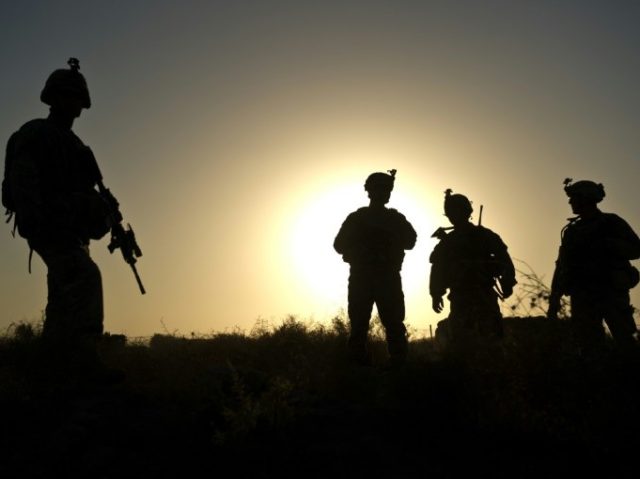The Taliban in the northern Afghan province of Badakhshan are increasingly capturing weapons and other military equipment, including armored vehicles, from U.S.-trained and equipped Afghan National Defense and Security Forces (ANDSF) and using them against the troops.
“As the result of incompetence,” the Taliban has stolen “more than 200” ANDSF vehicles, likely funded by the U.S. taxpayer, in just the last two months, former Afghan spy chief Rahmatullah Nabi told TOLO News.
The Afghan news outlet reports:
Badakhshan provincial governor said that in the past year, the Taliban has managed to seize the equipment, including light and heavy weapons as well as armored vehicles – which has become an increasing problem for security forces.
Faisal Bigzad, the provincial governor, has requested assistance from his government and the international community, to no avail.
“We have asked the [Afghan] ministry of defense and [the U.S.-NATO] Resolute Support to destroy these [stolen] vehicles,” declared Bigzad.
According to the Special Inspector General for Afghanistan Reconstruction (SIGAR), a U.S. watchdog agency appointed by Congress, the U.S.-funded Afghan government has recently lost control of more than one-third of their nation, particularly to the Taliban.
TOLO News points out that, in the northeastern province of Badakhshan alone, the jihadist group “controls much of Wardoj and Yamgan districts and are widely active in eleven other districts in the province.”
That means the Taliban either controls or is active in nearly half of all 28 districts in Badakhshan, a province that was able to escape the terrorist group’s rule when it was in power until the U.S. military ousted them in 2001.
“In 2015 a number of Afghan forces’ armored vehicles were seized by the enemy in Wardoj, Jurm and Yamgan valley and there is no doubt that those vehicles need to be destroyed so that they cannot be used against them [Afghan troops],” said Bigzad
Badakhshan is located in northeast Afghanistan along the borders of Tajikistan, Pakistan, and China. According to SIGAR, the majority of security incidents in Afghanistan occur in provinces that border Pakistan.
In March, Russia and its ex-Soviet ally Tajikistan conducted “large-scale military drills” near the Tajikistan-Afghanistan border, reported Agence France-Presse (AFP), noting that Russia is considering deploy troops to that region in response to the deteriorating security situation in the region.
In July, China also provided military aid to Afghanistan via a Russian plane as President Barack Obama voiced plans to further reduce the presence of U.S. troops in the country.
Obama, who escalated the Afghanistan war soon after taking office in 2009, decided to end the U.S. combat mission and withdraw the bulk of the American troops out of the country amid a period of chaos in Afghanistan — the end of 2014, one of the deadliest years of the war for attacks carried out by the Taliban.
Despite about $70 billion in U.S. taxpayer funds invested on developing their capability and more than a decade of American military training, the ANDSF are still struggling to defend their country.
More than 15 years since the 9/11 attacks and Afghanistan is producing record levels of opium, a portion of which may be contributing to the heroin overdose related deaths in the United States; historic numbers of casualties are suffered by Afghan security forces and civilians; tens of thousands of U.S. military casualties, both deaths and injuries, including service members who lost body parts, recorded; and add to all of that an ever-multiplying Taliban and al Qaeda.
The TOLO report comes nearly a month after jihadists from the Islamic State (ISIS/ISIL) branch in the region released photos showing the identification card of a U.S. soldier, along with weapons and other military equipment confiscated from American troops in the terrorist group’s stronghold of Nangarhar province, in eastern Afghanistan, also along the Pakistan border.
ISIL-K seized an American portable rocket launcher, radio, grenades and other military gear.
Last November, an estimated 70 U.S.-backed Afghan security troops reportedly handed over their weapons and equipment and surrendered to the Taliban in the restive Helmand province, the most poppy-producing and deadliest region for U.S.-led coalition forces that despite nearly 15 years of war, it is still primarily controlled by the Taliban. Helmand is also located along the Pakistan border.
Furthermore, the Pentagon lost track of at at least 750,000 guns provided to security forces in Afghanistan and Iraq during 14 years of the ongoing war on terror, a tally by Action on Armed Violence (AOAV), a London-based charity, reveals.

COMMENTS
Please let us know if you're having issues with commenting.